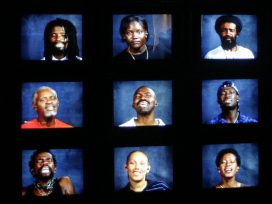
On the border between Poland and Belarus, the Forest has become the subject of a humanitarian crisis. An artist’s report, based on meetings with activists and refugees, charts this contested space. Poetry honours those lost in transit.
Art criticism today has become reliant on the system its job is to criticize. With little alternative to institutional advertising, art magazines are unwilling to upset clients, while the boundary between criticism and commercial marketing is increasingly blurred.
It is no secret that the field of criticism as a writerly practice – in art, music, literature, what have you – is in some disrepute today, despite the preponderance of the term. The reasons for the stepchild status of criticism are as manifold as are their concatenations, not the least of which is the problem of identifying a shared idea or point of orientation when it comes to the practice.
A brief tour through sundry monikers, prizes and teaching positions could lead one to believe that criticism is alive and well; and maybe it is. But the life, or afterlives, or criticism are not my concern here. Rather, I want to outline a brief and altogether inadequate topology of art criticism – the child of the family I am most familiar with –a short flyover, if you will, that will do no lasting damage to those who feel invited to the critical party and are happy to have scored their ticket.
It is certainly right to wonder why the hullaballoo now – where’s the fire? Well, one could point to a recent and hitherto unimaginable case concerning public funding for text-based criticism that emerged in recently in Germany, which prompted some – especially those of us from countries where public funding is more pie in the sky than political reality – to gaze on in perverse fascination while one independent journal dragged another into court under the auspices that the accused had managed to find a loophole in the funding of print criticism.
I won’t rehash the details here, just to say that it gave many of us pause, time to consider the history and legality of the German state’s refusal to offer any form of financial support for journals, magazines, the printed rags at large.

View of the Tate Modern. Author: hiro kobashi. Source: Wikimedia Commons
And therein lies at least one of just many slippery slopes for criticism. Pushed into the gaping maw of private, commercial funding, ‘critics’ are either safe because they do not rely on their craft for their livelihood (e.g. have a full-time gig elsewhere), or are completely at the mercy of being accepted and published by the handful of outlets left in the print world (not many). As a former editor of two such magazines (I hesitate to call it criticism at this point, more on that later), I experienced first-hand in nearly four years of work the anxiety of younger writers who feared being ostracized from the circle of the willing should they tear something apart in a review.
Mind you, just being negative or ‘critical’ is not necessarily equivalent to the practice of criticism, at least not for me. This is too narrow a definition, more a symptom of the problem than the crux of it. But the reality of writers living and working in Germany is adversely affected by these circumstances, not to mention the pay, which is barely enough to cover your gas bill if you manage to churn out three or four pieces a month. More than that is anyway unrealistic, given the exhibition schedules that last around a month for private galleries, and three to six months for larger institutions. We are barely scratching the surface here and already the system of checks and balances is completely out of whack.
Would public funding solve such a state of affairs? There is no panacea, and I would not hitch my wagon to one even if I were briefly moved to do so. But it is clear that the decision to fund a diverse range of cultural practices in the Germany – experimental theatre, artistic research, spaces for the preservation of outdated technology – means that they are under no similar existential threat, even if they are not exactly thriving either.
*
I cannot adequately speak to what the bureaucrats should be up to behind the scenes. But I can, with some experience, speak to the quality and kind of art criticism that is published in Germany. Call it what you like, but in any practice – documentary film, memoirs, TikTok – there is a field in which things are produced and consumed. Criticism provides a healthy awareness of the boundaries of such a terrain, and by extension, their inherent limitations. That people who write for the cultural pages can call themselves critics is a recent development, as is the act of putting your name and texts forward to a committee to receive an art criticism prize. There really are about five places to look for published criticism in the German language. Is it too much to ask that a committee be aware of them? I am digressing.
Criticism, at least as it might have developed in the recent field of writing about art, started out at odds with the feuilleton, sharpening its teeth against the belletrism of a writerly practice with a deep-seated conviction in, and reliance on, the experiential. What feuilleton-esque writing failed to account for was the formal complexity and intelligence of the works they considered, reliant as they were on the euphony of their prose and the adequacy of their feelings. In western Europe, I do not think it entirely coincidental that materialist inquiry into the invisible forces of industrialism emerged almost simultaneously with a critical enterprise whose analysis centred on systems – like the art market – and the things that belong to them (read: art).
Of course, these categories do not account for a field that is watery and vague at the moment, but I insert this little historical fact if only to give some pause about who or what folks are calling a critic or criticism when they use these much-maligned terms. Recent symposia could be mentioned in which such terms were thrown around with as much a-criticality and historical blind spots as could be imagined, taking the mere ‘writing about art’ as a given, an enterprise that sits comfortably between things produced within a field called art by thinking individuals.
A cursory comparison of the exhibition texts produced and promoted by commercial galleries with those published in supposedly ‘independent’ art publications reveals that not only is there almost no distinguishable difference of quality, but that the authors of said texts are often one and the same. Again, no begrudging from me. People have to make a living, but this puts the question of public funding for independent criticism into pretty high relief. Magazines are almost completely reliant on advertising to support their costs, and no institution or gallery, however financially solvent, is going to put money into a publication that never bothers to write about one of their exhibitions.
Most behind the scenes would deny such claims, or qualify them with other means, but it is an almost universal fact: there is no independent art publishing, at least not in the way that is used by the German government as justification for refusing to fund writing about art and culture. It’s like a simple logical formula. If the inverse of a given axiom is true, then you have your proof. Here, if there really is no independent writing, free from the forces of influence, then the decision by the government to stay out of the game is predicated on a falsehood.
This is to say nothing of the effects that this state of affairs is having on the practice of criticism, which is of course tied to this reality and, I would argue, deeply exacerbated by it. I am sure that many will point to book projects, catalogues and other print ephemera that received some state funding as part of a larger endeavour. But having published both in academia and in the magazine industry, I can confirm that there is one glaring difference: speed. The time and coordination it takes for a book or edited volume to appear means that whatever arguments, ideas, proposals, analysis or whatever have contributed to its final form are so old as to no longer maintain any critical tension with their subjects – the ship has sailed.
For the university, peer review is a guaranteeing of scholarly security. Like the Feuilleton of the 19th century, criticism is at odds with such safety measures, written and produced as it is without the usual referential armature and institutional propping. One magazine that I edited went so far as to have a policy of not publishing footnotes – never ever!
There is currently so much handwringing around ChatGPT taking over marketing and publication departments that the conversation risks becoming completely out of touch with the pressures facing writing about art, music or something else. Yet, if only to offer some words of caution, it matters that the grounds for the German government to refuse state funding for criticism are as watery as the field of criticism itself. Are writers today more secure in their belief that they are not influenced by interests that might otherwise compromise their freedom of expression?
I don’t know, is the short answer, but I can say that after having worked closely with young writers, I never once heard those sentiments uttered, either for or against. These individuals were too concerned with securing the next gig and making sure that they got paid for the current one.
*
For many of us in the field, there is a tremendous freedom in not having to line up with a particular school or ideology when writing about art. But the time required to really look, think and formulate something adequate to the complexity of what we experience has developed in parallel with our liberation from the grand narratives and domineering voices. Really, the elephant in the room is: why isn’t the writing on par with the art?
An evaluation of such a state of affairs necessarily invites all of the old ghosts into the room, the ones we were happy to have excised; and were it not for the critical faculty of judgment, I think the entire field should just be called something else. The fact that criticism today is such a by-product of other systems – the press release, marketing departments, promotion, hype, etc. – that have little or no resemblance to the forces of yesteryear does not necessarily signal an end to criticism, or what Bruno Latour celebrated when he penned, ‘Why critique has run out of Ssteam’.
If he meant hot air – ok, good riddance. The quality and kind of critical writing produced is one issue, but the larger question of the arbitrary refusal to fund wonderful little publications who can give their writers a bit of shelter from the vagaries of the market is certainly worth reconsidering, without necessarily dragging your colleagues into court in order to do so. No one in their right mind could imagine criticism as an ideology today, or even a decent livelihood, whereas the fields that are subsidized – art and artistic research chief among them – are just as susceptible to the erosions of judgment, time and careful consideration.
Published 23 October 2023
Original in English
First published by Positionen 136 (2023) (German version); Eurozine (English version)
Contributed by Positionen © Colin Lang / Positionen / Eurozine
PDF/PRINTSubscribe to know what’s worth thinking about.

On the border between Poland and Belarus, the Forest has become the subject of a humanitarian crisis. An artist’s report, based on meetings with activists and refugees, charts this contested space. Poetry honours those lost in transit.

The white saviour, driven by a moral mission, benefits from the oppression they claim to resist. Reactions to the plight of ‘victims’ often fail to translate into concrete actions, leaving those in need of care begging for sympathy. Could acknowledgement of individual complexity to the point of mystery alter this dynamic?